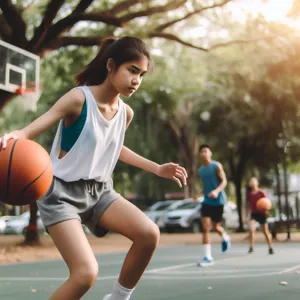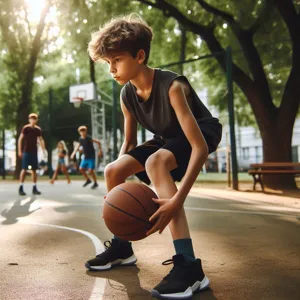Basketball is more than just a game; it’s a thrilling dance of agility, precision, and strategy played out on the hardwood court.
At the heart of this dynamic sport lies one essential skill that can make or break a player’s performance: ball-handling. Whether you’re a beginner looking to dribble with confidence or an experienced player aiming to refine your technique, mastering the art of ball-handling is crucial for elevating your game. The ability to control the basketball not only enhances your offensive capabilities but also empowers you to navigate through defenders with finesse and create scoring opportunities. In this comprehensive guide, we will explore seven essential tips designed to transform your ball-handling skills, helping you to dazzle on the court and outsmart your opponents. Get ready to break through your limits and elevate your basketball game to new heights!
1. Understanding the Importance of Ball Handling in Basketball

When it comes to basketball, mastering the fundamentals is crucial, and one of the most critical skills every player must develop is ball handling. Understanding the importance of ball handling goes beyond simply dribbling the ball; it encompasses the ability to control the game, create scoring opportunities, and maintain possession under pressure. Strong ball-handling skills can be the difference between a good player and a great one.
At its core, ball handling allows a player to navigate the court with confidence and poise. It enables you to change directions quickly, evade defenders, and make precise passes—all essential elements for executing plays effectively. A player who possesses excellent ball-handling skills can dictate the pace of the game, orchestrate offensive strategies, and create spacing for teammates, making them invaluable on the court.
Moreover, ball handling is not just about individual prowess; it’s about elevating the entire team’s performance. When you can handle the ball with finesse, you can draw defenders in, open up lanes, and facilitate scoring for your teammates. This versatility is particularly crucial in high-pressure situations where decision-making and quick reflexes are paramount.
Additionally, ball handling fosters a sense of rhythm and flow in your gameplay. The more comfortable you become with the ball, the more natural your movements will feel. This fluidity allows you to focus on other aspects of the game, such as reading defenses and anticipating plays, thereby enhancing your overall basketball IQ.
In summary, understanding the importance of ball handling in basketball means recognizing it as foundational to your success on the court. It is a skill that requires dedication and practice, but the rewards—greater confidence, improved performance, and the ability to elevate your game—are well worth the effort. Whether you are a beginner or looking to refine your skills, prioritizing ball handling is the first step toward mastering the court.
2. Assessing Your Current Skill Level
Before you can embark on the journey to elevate your basketball ball-handling skills, it’s crucial to take a step back and assess your current skill level. This self-evaluation is the foundation upon which you’ll build your improvement, allowing you to identify strengths, weaknesses, and specific areas that need focus.
Start by setting aside some time on the court with a basketball in hand. Engage in a series of fundamental drills that highlight different aspects of ball-handling—dribbling, passing, and footwork. Observe how comfortable you feel while performing basic moves like crossovers, behind-the-back dribbles, and in-and-out dribbles. Are your movements fluid and controlled, or do you find yourself struggling to maintain possession?
Next, consider recording yourself during these drills. Watching the footage can provide invaluable insight into your technique, revealing habits that may be hindering your progress. Pay attention to your body posture, hand placement, and dribble height. Are your eyes up, scanning the court for potential plays, or are they glued to the ball? A successful ball handler always maintains awareness of their surroundings.
Additionally, seek feedback from coaches or experienced players. They can offer a fresh perspective on your skill level, pinpointing areas that are working well and those that require improvement. Be open to constructive criticism; it’s a vital part of the learning process.
Finally, take stock of your basketball IQ. Understanding the game goes hand in hand with ball-handling skills. Assess your knowledge of plays, defensive strategies, and teamwork dynamics. The more you know about how the game operates, the better you can adapt your ball-handling to various situations on the court.
By thoroughly evaluating your current skill level, you’ll set a clear path for your development. This foundation will empower you to implement targeted drills and strategies, ultimately enhancing your ball-handling ability and boosting your overall performance on the court.
3. Tip 1: Focus on Fundamentals – Dribbling Techniques

When it comes to mastering basketball, the foundation of your skills lies in the fundamentals, particularly in the art of dribbling. Dribbling is not just about bouncing the ball; it’s a dynamic dance that requires precision, control, and awareness. To elevate your ball-handling skills, begin by honing your dribbling techniques, as they will serve as the bedrock for your overall game.
Start with the basics: ensure that you’re using your fingertips to control the ball rather than your palms. This grip offers better tactile feedback and allows for quicker reactions as you maneuver on the court. Practice dribbling the ball low and close to the ground, which increases your control and makes it harder for defenders to steal the ball. As you become comfortable, experiment with different heights and angles, learning to adapt your dribbling to various game situations.
Incorporate drills that emphasize both stationary and dynamic dribbling. Set up cones in a zigzag pattern and practice dribbling around them, focusing on keeping your head up to maintain court awareness. This drill not only sharpens your ball-handling skills but also trains you to read the defense and make split-second decisions. As you progress, include changes of pace and direction; learning to accelerate or decelerate while maintaining control can give you a significant edge during games.
Finally, don’t overlook the importance of practicing with both hands. A versatile player who can dribble proficiently with either hand is much harder to defend against. Dedicate time to strengthening your non-dominant hand, gradually incorporating it into your dribbling drills. By focusing on these fundamental techniques, you’ll not only improve your ball-handling skills but also build the confidence needed to take your game to the next level. Remember, every great player started with mastering the basics; solid dribbling techniques will pave the way for your success on the court.
4. Tip 2: Practice with Both Hands – Ambidextrous Dribbling
When it comes to basketball, being proficient with one hand can only take you so far. To truly elevate your ball-handling skills, it’s essential to practice with both hands. This ambidextrous approach not only enhances your versatility on the court but also keeps defenders guessing and off-balance.
Start by incorporating simple drills that force you to use your non-dominant hand. Begin with stationary dribbling—bounce the ball up and down while focusing solely on your weaker hand. This may feel awkward at first, but with consistent practice, it will gradually become more natural. As you gain confidence, progress to dribbling while walking or jogging, then to more dynamic movements like crossovers or behind-the-back dribbles.
Incorporating cones or markers into your routine can further challenge your skills. Set up a series of obstacles and practice weaving through them while using your non-dominant hand. This not only improves your dribbling but also enhances your ability to change direction quickly, a critical component of effective ball handling in game situations.
Moreover, don’t forget to integrate shooting drills that require you to finish with your weaker hand. Layups and jump shots from various angles will help solidify your overall skill set, allowing you to attack the basket confidently from either side.
The more you train your non-dominant hand, the more balanced and unpredictable your game will become. Remember, even the greatest players, like Stephen Curry and LeBron James, emphasize the importance of being proficient with both hands. So, embrace the challenge—your future self on the court will thank you!
5. Tip 3: Incorporate Dribbling Drills into Your Routine

Incorporating dribbling drills into your routine is a game-changer when it comes to mastering basketball ball-handling skills. consistency is key, and dedicating time to focused practice can significantly enhance your dexterity, control, and agility on the court.
Start by integrating a variety of drills that target different aspects of dribbling. For instance, begin with stationary ball-handling exercises like the “figure-eight” drill, where you weave the ball in a figure-eight pattern between your legs. This drill not only improves your hand coordination but also enhances your ability to protect the ball from defenders. As you become more comfortable, elevate the intensity by transitioning into movement drills. The “Zig-Zag” drill, where you dribble in a zig-zag pattern while changing speeds and directions, is excellent for developing agility and understanding how to maneuver around defenders.
Another effective drill is the “two-ball” drill, where you dribble two basketballs simultaneously. This not only challenges your hand-eye coordination but also forces you to focus on maintaining control with both hands, a crucial skill for any player seeking to elevate their game.
Don’t forget to incorporate game-like scenarios into your drills. Set up cones or markers to simulate defenders, allowing you to practice your moves in a realistic context. This will help you build muscle memory and improve your decision-making skills as you learn to read the defense and react accordingly.
Lastly, consider tracking your progress. Set specific goals for each practice session, whether it’s a certain number of successful crossovers or maintaining a dribble without losing control under pressure. By holding yourself accountable and regularly challenging your skills, you’ll notice significant improvements over time.
By making dribbling drills an integral part of your training regimen, you’ll not only refine your skills but also gain the confidence needed to handle the ball like a pro when it matters most on the court.
6. Tip 4: Improve Your Footwork for Better Control
Footwork is the foundation of effective basketball ball-handling, and improving it can significantly elevate your game. Great ball handlers aren’t just defined by their dribbling skills; they also possess quick, agile foot movement that allows them to navigate the court with ease. By honing your footwork, you can create space, evade defenders, and maintain better control of the ball.
Start by practicing basic footwork drills that focus on your agility and balance. Simple exercises like ladder drills or cone drills can enhance your foot speed and coordination. As you improve, incorporate these movements into your dribbling practice. For instance, try performing crossovers or behind-the-back dribbles while constantly shifting your feet in different directions. This will help you develop a sense of rhythm and flow, allowing you to react quicker during games.
Additionally, pay attention to your stance. A low, balanced position allows for better control and quicker movements. When you’re dribbling, keep your knees slightly bent and your weight distributed evenly on the balls of your feet. This stance will not only help you maintain balance but also make it easier to pivot or change direction at a moment’s notice.
Remember to practice with purpose. Incorporate game-like scenarios into your training sessions, such as simulating defensive pressure while focusing on your footwork. This will not only improve your ball-handling skills but also build your confidence in real-game situations.
By dedicating time to refine your footwork, you’ll find that your overall control of the ball improves dramatically. This essential skill will enable you to maneuver past defenders, create scoring opportunities, and elevate your performance on the court.
7. Tip 5: Use Cones and Obstacles for Enhanced Agility

In the world of basketball, agility is as crucial as ball-handling skills, and one of the most effective ways to sharpen both is by incorporating cones and obstacles into your training regimen. This tip might seem simple, but the benefits it brings to your game can be transformative.
To get started, set up a series of cones or other obstacles in varying patterns across your court. You can arrange them in straight lines, zigzags, or even create more complex shapes that require rapid direction changes. The key here is to challenge yourself—vary the distances between the cones and the angles at which you approach them.
As you navigate through these obstacles, focus on maintaining control of the ball while executing dribble moves such as crossovers, behind-the-back dribbles, and spin moves. This not only enhances your ball-handling skills but also simulates the unpredictable nature of a real game, where defenders can come at you from all angles.
Moreover, working with cones sharpens your footwork. As you weave in and out, your ability to pivot and change direction quickly will improve, allowing for smoother transitions when you need to evade defenders on the court. Incorporate speed drills, where you sprint to the next cone, then slow down to execute a dribble move before accelerating again. This will help you develop both speed and control.
Don’t forget to challenge yourself further by timing your runs or competing with a friend. Setting personal bests can add an element of fun and motivation to your practice sessions. By consistently integrating cones and obstacles into your drills, you’ll build the agility needed to navigate through defenses with ease, making you a more formidable player on the court.
8. Tip 6: Develop Your Awareness – Head Up Dribbling
When it comes to basketball, the ability to dribble with your head up is a game-changer. It’s not just about moving the ball; it’s about enhancing your court awareness and making smarter decisions in real time. Developing your awareness through head-up dribbling means training yourself to keep your eyes scanning the court, rather than fixating on the ball. This skill allows you to read the defense, locate open teammates, and spot potential passing lanes, giving you a significant advantage during gameplay.
To cultivate this essential skill, start by practicing dribbling drills that encourage you to focus on your surroundings. Set up cones or markers around the court and navigate through them while maintaining your head up. Challenge yourself to call out the names of your teammates or identify defensive players as you weave through the obstacles. This exercise not only reinforces your dribbling technique but also sharpens your ability to process information quickly.
Additionally, incorporate vision training into your routine. Use tools like vision cones or contrast cards during your dribbling practice. These will help you train your peripheral vision and improve your ability to spot opportunities without needing to look directly at the ball.
Remember, the best ball-handlers in the game are those who can maintain control while keeping their heads up. This dual focus on dribbling and awareness will enhance your overall gameplay, allowing you to make quicker decisions, execute plays more effectively, and elevate your performance on the court. With consistent practice, you’ll soon find that dribbling with your head up becomes second nature, transforming you into a more dynamic and unpredictable player.
9. Tip 7: Work on Change of Pace and Direction
Mastering the art of change of pace and direction is one of the most effective ways to elevate your basketball ball-handling skills and leave defenders guessing. In the fast-paced game of basketball, being able to shift gears seamlessly can create space for your shot, open up passing lanes, and ultimately keep your opponents on their toes.
To develop this skill, start by practicing your dribbling at varying speeds. Begin with a controlled pace, maintaining a low center of gravity and keeping your eyes up to survey the court. As you become comfortable, gradually increase your speed, focusing on maintaining ball control. The key is to make your movements unpredictable; a sudden burst of speed or a quick slow-down can throw off even the most seasoned defenders.
Incorporate changes of direction into your practice regimen. This can be done through a series of drills that emphasize crossovers, behind-the-back dribbles, and hesitation moves. For example, try the “Zigzag Drill,” where you dribble in a zigzag pattern, alternating your pace and direction at each change of angle. This not only enhances your handling skills but also helps you develop a sense of timing and rhythm.
Another effective technique is the “Change of Speed Drill.” Start dribbling at a slow pace, then explode into a sprint for a few dribbles before transitioning back to a slow, controlled dribble. This drill mimics real-game situations where you’ll need to react quickly and adapt your speed based on the defender’s position.
Finally, don’t forget to practice these skills while incorporating defensive pressure. partner up with a teammate or coach who can play defense, forcing you to make quick decisions on the fly. This simulates game scenarios and helps you learn to read the defender’s movements, allowing you to exploit weaknesses in their positioning.
By mastering change of pace and direction, you’ll not only enhance your overall ball-handling skills, but you’ll also become a more formidable offensive player—one who can create opportunities for both yourself and your teammates. Remember, the best players are those who can keep defenders guessing, so embrace these techniques and watch your game elevate to new heights!
10. The Role of Conditioning in Ball Handling
Conditioning plays a pivotal role in elevating your basketball ball-handling skills, often serving as the unsung hero behind a player’s performance on the court. To truly master ball handling, it’s essential to recognize that skillful dribbling and precise control don’t just come from technique; they also stem from physical readiness and endurance.
When you’re conditioned, your body can move fluidly and efficiently, allowing you to execute complex dribbling maneuvers without the burden of fatigue. Imagine breaking down a defender with a series of swift crossovers and behind-the-back dribbles, only to find your legs giving out midway through—frustrating, right? That’s where conditioning comes in to save the day. It enhances your stamina, ensuring that you maintain peak performance throughout the game, even in the most intense moments.
Incorporating a robust conditioning regimen into your training routine can significantly improve your ball-handling abilities. Focus on exercises that build both aerobic and anaerobic fitness, such as sprints, agility drills, and plyometrics. These exercises not only improve your cardiovascular health but also increase your muscle strength and explosiveness—both crucial for quick, decisive movements with the ball.
Moreover, conditioning is about more than just physicality; it also sharpens your mental focus. When you’re physically fit, you can think clearly under pressure, allowing you to make split-second decisions that can change the game. Whether you’re navigating through a crowded lane or executing a no-look pass, your conditioning helps keep your mind sharp and your body responsive.
In summary, to elevate your ball-handling skills, prioritize conditioning as a foundational element of your training. By blending physical endurance with your technical skills, you’ll not only enhance your dribbling prowess but also transform into a more formidable player on the court. So lace up your sneakers, hit the gym, and prepare to see your ball-handling abilities soar!
11. Analyzing Professional Players’ Ball-Handling Skills
One of the most effective ways to elevate your own basketball ball-handling skills is to analyze the techniques of professional players. Watching the pros can provide invaluable insights into the nuances of ball handling that may not be as obvious during practice or casual play. Start by selecting a few of your favorite players known for their exceptional dribbling—think of stars like Kyrie Irving, Stephen Curry, or Chris Paul.
Begin by studying their movements: notice the way they create space from defenders, the rhythm of their dribble, and how they use their body to shield the ball. Slow-motion replays can be particularly helpful, allowing you to dissect each action frame by frame. Focus on how they read the defense and react accordingly, adapting their dribble to the flow of the game.
You can also find instructional videos or breakdowns online where analysts dissect specific plays or moves. Pay attention to the footwork involved; many elite ball handlers possess an understanding of angles and positioning that allows them to perform complex maneuvers with ease.
After observing these techniques, try incorporating them into your own practice sessions. Set up drills that mimic the moves you’ve analyzed, gradually increasing speed and intensity. By imprinting these professional skills into your muscle memory, you’ll not only enhance your ball-handling abilities but also develop a deeper understanding of the game. Remember, every great player started as a student of the game; by analyzing and learning from the best, you too can master the art of ball handling.
12. Creating a Personalized Ball-Handling Practice Plan
Creating a personalized ball-handling practice plan is a game-changer for any aspiring basketball player looking to elevate their skills. Just like any other athlete, you must tailor your training to suit your unique strengths, weaknesses, and goals. Begin by assessing your current ball-handling abilities; take note of which moves come naturally and which ones feel clumsy or awkward. This self-assessment will serve as your foundation.
Once you have a clear understanding of your skill level, outline specific objectives. Perhaps you want to improve your crossover dribble or develop a more fluid behind-the-back move. Setting measurable goals will help you stay focused and motivated throughout your training sessions.
Next, structure your practice plan to include a variety of drills that target these objectives. Start with fundamental exercises, such as stationary dribbling and figure-eight patterns, to build your foundational skills. Gradually incorporate more complex movements like spin dribbles, hesitation moves, and change-of-pace drills. Remember to balance your practice between both hands, as this will enhance your overall versatility on the court.
Duration and frequency are also key elements when designing your plan. Aim for short, intense practice sessions that maintain your energy and focus—around 30 to 45 minutes is ideal. Try to practice at least three to four times a week, allowing for rest days to prevent burnout and injury.
In addition to individual drills, consider integrating game-like scenarios into your practice. This could involve dribbling against a defender or setting up cones to simulate defensive pressure. By replicating the conditions you’ll face during a game, you’ll develop the ability to perform under pressure.
Finally, don’t shy away from tracking your progress. Keep a journal of your practice sessions, noting improvements, areas that still need work, and any insights you gain. Regularly revisiting your plan and adjusting it as you evolve will ensure that your training remains relevant and effective.
A well-crafted, personalized ball-handling practice plan not only sharpens your skills but also instills confidence. With commitment and consistency, you’ll master the court, leaving defenders scrambling in your wake as you weave your way to success.
13. Tracking Your Progress: Setting Goals and Milestones
Tracking your progress is a vital component of mastering basketball ball-handling skills. Just as players measure their shooting percentages, rebounds, or assists, setting specific goals and milestones for your ball-handling can provide the focus and motivation needed to elevate your game.
Start by defining clear, achievable goals. Instead of vaguely aiming to “get better,” specify what that means for you—whether it’s mastering a particular dribble move, improving your speed with the ball, or increasing your ability to handle pressure during games. Aim for SMART goals: Specific, Measurable, Achievable, Relevant, and Time-bound. For instance, you could set a goal of executing a behind-the-back dribble flawlessly 50 times in a row within two weeks.
Once you’ve established your goals, break them down into smaller milestones. These bite-sized achievements can act as stepping stones that keep you motivated along your journey. Perhaps aim to improve a certain skill each week, like enhancing your crossover dribble or your ability to switch hands seamlessly. Document your progress through a training journal or a digital app, noting not just what you accomplished but also how you felt during the practice sessions. This reflection can provide valuable insights into your growth and areas that need more attention.
Regularly reassess your goals and milestones. This allows you to adapt your training plan based on your evolving skills and any challenges you encounter. Celebrate your milestones—no matter how small. Recognizing these achievements will boost your confidence and reinforce your commitment to continuous improvement. By diligently tracking your progress, you’ll not only sharpen your ball-handling skills but also cultivate a mindset of discipline and perseverance that can significantly enhance your overall basketball performance.
14. Common Mistakes to Avoid While Practicing
When it comes to mastering ball-handling skills in basketball, practice is essential—but not all practice is created equal. Avoiding common mistakes during your training sessions can make the difference between merely going through the motions and truly elevating your game. Here are some pitfalls to watch out for:
1. **Neglecting Fundamentals**: It’s easy to get caught up in flashy moves and advanced techniques, but neglecting the basics can severely hinder your progress. Always start with foundational drills, such as stationary dribbling, and focus on maintaining proper hand placement and body posture. Mastering these fundamentals will provide a solid base for more complex skills.
2. **Overlooking Weaknesses**: Many players gravitate toward practicing their strengths, but this can lead to an imbalanced skill set. Identify your weaknesses—whether it’s weak hand dribbling, crossovers, or hesitation moves—and dedicate time to improving them. Embracing your shortcomings will make you a more versatile player on the court.
3. **Practicing Without Purpose**: Randomly dribbling the ball or executing moves without a clear goal can lead to ineffective practice sessions. Set specific objectives for each training session, whether it’s improving your speed, control, or the effectiveness of your change of pace. This focused approach will help you track your progress and ensure that every minute spent practicing counts.
4. **Ignoring Footwork**: Ball-handling is not just about your hands; footwork is equally important. Failing to integrate footwork drills into your practice can limit your ability to create space and navigate through defenders. Incorporate agility and footwork exercises to enhance your overall control and movement on the court.
5. **Practicing in Isolation**: While individual practice is crucial, neglecting to simulate game scenarios can hinder your development. Incorporate drills that mimic real-game situations, such as practicing against a defender or executing moves while on the move. This will help you build confidence and adaptability when facing opponents during actual games.
6. **Lack of Consistency**: Progress in ball-handling skills requires consistent practice. Skipping sessions or practicing sporadically can stall your improvement. Develop a regular training schedule and stick to it, treating each session as an important step in your journey to becoming a better player.
7. **Forgetting to Have Fun**: Finally, amidst all the drills and focused efforts, don’t forget to enjoy the game. Practicing ball-handling should be a fun and rewarding experience. Incorporate games and challenges into your practice sessions to keep your motivation high and your skills sharp.
By being mindful of these common mistakes, you can make the most of your practice time and take your ball-handling skills to new heights. Remember, the road to mastery is paved with dedication, focus, and a willingness to learn from your missteps.
15. Conclusion: The Journey to Mastering Ball Handling
As we wrap up our exploration of the essential tips to elevate your basketball ball-handling skills, it’s important to remember that mastery is not an overnight achievement. The journey to becoming a proficient ball-handler is filled with dedication, practice, and a willingness to learn from both successes and failures. Just like the greats of the game, your path will be marked by countless hours on the court, honing your skills, and pushing your limits.
Every dribble, pass, and move you make is a building block in your basketball repertoire. Embrace the process—celebrate the small victories, whether it’s nailing that tricky crossover or perfecting your behind-the-back dribble. The more you practice, the more instinctual these movements will become, allowing you to play with confidence and creativity when the game is on the line.
Moreover, don’t forget the importance of feedback. Whether it’s from a coach, a teammate, or even video analysis, constructive criticism can provide invaluable insights into areas for improvement. Keep an open mind and be willing to adapt your techniques; basketball is a dynamic game, and the best players are those who can evolve with it.
Finally, maintain your passion for the sport. Your love for basketball will serve as the fuel that drives you through the challenging days when the ball doesn’t bounce your way. Surround yourself with fellow basketball enthusiasts, engage in friendly competitions, and keep the joy of the game at the forefront of your journey.
With commitment and the right mindset, you’ll not only elevate your ball-handling skills but also deepen your appreciation for the game itself. So lace up your sneakers, hit the court, and enjoy the journey to mastering ball handling—your future self will thank you.
As you embark on your journey to mastering the court, remember that improving your basketball ball-handling skills is a gradual process that requires dedication, practice, and a positive mindset. The seven essential tips we’ve outlined serve as a solid foundation to elevate your game, whether you’re a beginner honing your craft or an experienced player looking to refine your technique. Embrace the drills, challenge yourself with new moves, and, most importantly, enjoy the process of growth and improvement. With perseverance, you’ll not only enhance your ball-handling skills but also gain confidence and agility on the court. So lace up your sneakers, hit the practice court, and let your passion for the game shine through as you implement these strategies—your teammates and fans will surely notice the difference!






